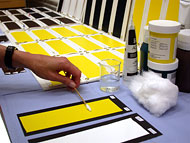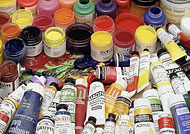An Evaluation of Cleaning Methods for Modern Paintings
The removal of surface dirt and/or varnish (i.e., cleaning) from the surface of a paint film is arguably the most routine treatment carried out on painted surfaces. Although much is now known about the relative efficiency and potential risks of various cleaning techniques for traditional oil paints, an equivalent awareness of the short- or long-term effects on modern and contemporary works of art, especially those executed with synthetic paints, is far less established. From the beginning of the project, research into the cleaning of modern paints has therefore been a priority—in particular, to find effective methods for removing surface dirt (the majority of modern paintings are not varnished) and to evaluate the possible consequential long-term damage to paint films as a result of cleaning. Much of this work has been carried out in collaboration with Tate - see, for example, the Tate AXA Art Modern Paints Project.

|
|
Work Completed
Much of the research to date has focused on the surface cleaning of acrylic emulsion paints, by far the most commonly used synthetic artists' paint, although more recently the high water-sensitivity of some modern oil paints has also been investigated. The work on acrylic emulsions has been largely led by researchers at Tate, where over 600 samples of acrylic emulsions, both pigmented and clear, have been painted out onto a range of substrates, including canvas, primed canvas, and solid supports. A selection of these paint samples were then subjected to accelerated (i.e., artificial) aging, including both thermal and light aging regimes. A range of various wet and dry cleaning techniques were applied to the dried films, and consideration of each cleaning treatment has included close examination of the surfaces of paint films before and after cleaning to assess gloss, color, and surface texture changes, as well as the measurement of changes in the films' physical properties, such as strength, hardness, and brittleness.
A range of analytical techniques have been assessed for potential monitoring of changes that might occur with cleaning treatments, many of which have been capable of detecting the presence of polyethylene oxide surfactants on the surfaces of acrylic films and their rapid removal with aqueous cleaning systems. Changes have also been measured in the thermal properties of acrylic emulsion films, largely with dynamic mechanical analysis (DMA), and by differential scanning calorimetry (DSC). The results have indicated that although minor changes to Tg do occur with both aging and extreme cleaning treatments, such as immersion in water, the changes are generally minimal, with relatively little loss of film flexibility.

|
|
The DMA experiments have also been used to approximate the effect of swelling the paints when fully immersed in water. The results show that the paints become far more flexible when immersed in water, and can stretch to a significant degree when subjected to a constant end-to-end force. The technique was also used to confirm that the exposure time of any of the water-based systems is critical, in that the swelling/softening of these films increases substantially with increased exposure. It may be, therefore, that the paints may benefit from being dried quickly after treatment with water-based systems to prevent unnecessary swelling.
Changes to the chemistry of acrylic emulsion paint films after cleaning and aging has been primarily documented using FTIR, with an ATR attachment. This attachment facilitates the gathering of data from the surface layer of the paint films, and hence reflects changes to surface chemistry only. The experimental work carried out thus far is in agreement with some initial findings that the surfactants are water-soluble and can be removed by swab rolling with water and by water immersion. The aging studies also confirmed that the evaporative action of both light (enhanced museum conditions) and thermal (heat) aging regimes resulted in either a decrease or the complete removal of the surfactants. This is supported by the DMA tests, which confirmed that only minor or negligible changes in film flexibility occur after the complete removal of the surfactant layer.
Work in Progress
Further assessments of analytical techniques are being carried out to monitor potential changes to paint films after cleaning treatments, including dynamic mechanical analysis (DMA) as a powerful tool to monitor changes in thermal properties, gas chromatography/mass spectrometry (GC–MS), and size-exclusion chromatography (SEC) to identify soluble extracts after cleaning and atomic force microscopy (AFM) and/or environmental scanning electronic microscopy (ESEM) to assess surface changes.
A collaboration was recently established with Dow Chemical Company, which has considerable expertise in both coatings formulations and developing cleaning products, and we are currently working together to assess ways of improving the cleaning potential of a number of systems, including those based on mineral spirits.
A workshop on the cleaning of acrylics is also being planned so that the results of all this research can be placed in context, and made more directly accessible to practicing conservators.
Page updated: January 2009
